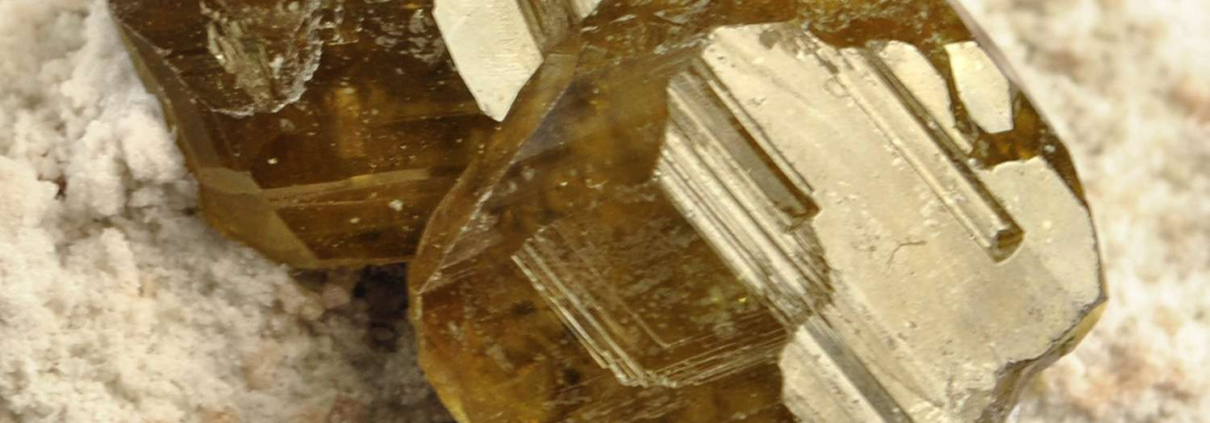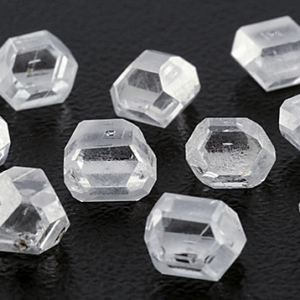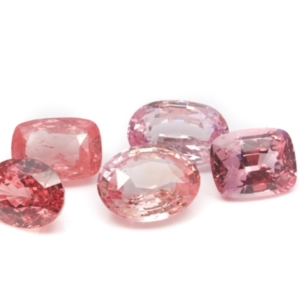Topazolite
Topazolite is a variety of the mineral andradite, which is a member of the garnet group. It is known for its yellow to yellow-green color, which is distinct within the garnet family. Topazolite typically appears in small, well-formed crystals that are highly prized by collectors for their brilliance and clarity.

Topazolite is a calcium iron silicate characterized by the formula Ca3Fe2(SiO4)3. It belongs to the garnet group, specifically falling under the andradite category, which also includes other varieties like demantoid and melanite. Topazolite garnets are typically translucent to transparent, making them desirable for both gemstone collectors and jewelry applications, although they are less commonly used in jewelry due to their rarity compared to other garnets.
The gemstone’s physical properties, including its hardness and refractive index, make it comparable to other garnets, which are known for their durability and lustrous appearance. The distinctive yellow hue of topazolite comes from its iron content, which imparts the color variations ranging from golden yellow to greenish-yellow, depending on the specific conditions of its formation.
Contents
- Etymology and Origin of the Name
- Geological Background of Topazolite
- Formation and Occurrence
- Geological Environments Where Topazolite is Found
- Physical and Chemical Properties of Topazolite
- Major Mining Regions and Deposits of Topazolite
- Uses and Applications of Topazolite
Etymology and Origin of the Name
The name “topazolite” is derived from its resemblance in color to topaz, although it is chemically and physically unrelated to topaz, which is a silicate mineral of aluminum and fluorine. The suffix “-lite” in topazolite suggests its classification and relation within the mineral world, often used to denote minerals in the same way as in names like zeolite or perlite.
Topazolite was first identified and named in the 19th century, recognizing its topaz-like color but distinct mineral composition. Its geological formation typically occurs in metamorphic rocks and is often associated with contact zones where high temperature and pressure conditions prevail, such as those found near igneous intrusions.
This mineral is relatively rare compared to other types of garnet, with notable deposits found in places like Italy, the Ural Mountains in Russia, and various locations in California, USA. Its unique beauty and rarity continue to make it a sought-after specimen for gemstone enthusiasts and mineral collectors alike.
Geological Background of Topazolite

Topazolite, as a variant of andradite garnet, forms under specific geological conditions. It is typically found in metamorphic and igneous environments where the necessary elements and conditions for garnet formation are present.
Formation and Occurrence
Topazolite garnets form through metamorphic processes, particularly in rocks that have been altered by high temperatures and pressures. These conditions facilitate the reaction between silicate minerals and iron-rich fluids, leading to the formation of andradite crystals, including topazolite. The presence of iron is crucial, as it contributes to the distinctive yellow coloring of topazolite.
In addition to metamorphic settings, topazolite can also occur in igneous rocks, particularly those associated with skarns. Skarns are calcium-rich silicate rocks that form at the contact zone between igneous intrusions and carbonate rocks such as limestone or dolomite. The thermal influence of the magma on the surrounding carbonate rocks leads to chemical reactions that produce a variety of minerals, including garnets like topazolite.
Geological Environments Where Topazolite is Found
- Skarns: These are perhaps the most common geological setting for topazolite. The interaction between magma and carbonate rocks creates a rich chemical environment where iron and other elements necessary for topazolite formation are available. These conditions promote the crystallization of andradite garnets.
- Metamorphosed Iron-rich Sedimentary Rocks: In some regions, topazolite forms within iron-rich sedimentary rocks that have been subjected to metamorphism. The iron in the sedimentary matrix, under heat and pressure, reacts with silicate minerals to form garnet.
- Contact Metamorphic Zones: Areas near the contact between igneous intrusions and surrounding rocks are favorable sites for topazolite. The heat from the igneous material metamorphoses the adjacent rocks, creating conditions conducive to garnet formation.
Notable locations for topazolite include parts of Italy, where it was first identified; the Ural Mountains in Russia, known for a variety of garnet species; and California, USA, where it has been found in association with skarn deposits. Each of these locations provides a unique set of geological conditions that facilitate the formation of this rare and beautiful garnet variant.
Physical and Chemical Properties of Topazolite

Topazolite shares many properties with other members of the garnet family but is distinguished by its unique coloration and specific chemical composition. Here’s a breakdown of its key physical and chemical properties:
Chemical Composition
- Formula: Ca3Fe2(SiO4)3. Topazolite is primarily composed of calcium, iron, and silicon, forming part of the andradite garnet group. The iron content is responsible for its characteristic yellow to yellow-green color.
Physical Properties
- Color: Ranges from yellow to yellowish-green, depending on the iron content and the specific conditions under which the garnet formed.
- Crystal System: Isometric. Topazolite forms dodecahedral or trapezohedral crystals, which are typical of the garnet group.
- Hardness: Measures around 6.5 to 7 on the Mohs scale, making it relatively hard and suitable for various jewelry applications, although it is more often collected as a mineral specimen due to its rarity.
- Luster: Exhibits a vitreous to resinous luster, contributing to its appeal as a gemstone.
- Transparency: Topazolite can range from transparent to translucent, enhancing its desirability for both gemological and ornamental purposes.
- Refractive Index: Typically ranges from 1.88 to 1.94, which is quite high and indicative of significant brilliance when cut and polished.
- Specific Gravity: Generally falls between 3.65 and 3.8, which is consistent with other garnets and indicative of a relatively dense mineral.
- Cleavage: Like other garnets, topazolite has no true cleavage, which is a characteristic that contributes to its toughness and durability in jewelry settings.
- Fracture: Exhibits conchoidal to uneven fracture patterns, typical of garnets.
Stability
- Chemical Stability: Topazolite is chemically stable, resistant to most acids except for hydrofluoric acid.
- Thermal Stability: It has good thermal stability, which allows it to withstand moderate temperature changes without damage.
Topazolite’s unique combination of beauty, durability, and rarity makes it a sought-after mineral for collectors and gem enthusiasts. Its physical and chemical characteristics also contribute to its distinctiveness within the diverse family of garnet minerals.
Major Mining Regions and Deposits of Topazolite

Topazolite is relatively rare compared to other garnets, which limits the number of significant mining regions worldwide. The major sources of topazolite are often associated with specific geological settings that include skarns and metamorphic rocks where the right combination of temperature, pressure, and chemical elements exists to form this mineral. Here are some notable regions known for their topazolite deposits:
1. Italy
- Val Malenco, Lombardy: This area is particularly famous for its diverse range of minerals, including several types of garnets. Topazolite from Val Malenco is known for its vibrant yellow color and high clarity, making these specimens highly prized.
2. Russia
- Ural Mountains: A historically rich mining region for a variety of minerals, the Ural Mountains have been a source of topazolite as well. The garnets from this area are often found in association with skarns that have formed due to the intrusion of magma into carbonate rocks.
3. USA
- California: California has multiple locations where topazolite is found, especially in areas with a history of skarn formation. Localities such as the Stanislaus Mine in Calaveras County and the Birdseye Mine in Kern County are known for their garnet specimens.
- Virginia: Some smaller deposits of topazolite have been found in Virginia, associated with skarn environments created by the contact between igneous intrusions and limestone.
4. Madagascar
- Antetezambato: Madagascar is renowned for its rich deposits of gemstones, including topazolite. The garnets from Madagascar are known for their exceptional quality and clarity.
5. Namibia
- Erongo Region: Namibia’s Erongo region is another prolific area for various minerals, including topazolite. The unique geological formations of this region contribute to the wide variety of minerals that can be found here.
These regions represent the primary sources of topazolite in the world. Due to its rarity, topazolite is more often collected for mineral collections rather than being mined extensively for gemstone use. The deposits are usually small and sporadic, making large-scale commercial extraction unfeasible. Instead, topazolite is typically collected by mineral enthusiasts and small-scale local miners. The appeal of topazolite lies in its rarity and the beauty of its crystals, which makes it a coveted specimen for collectors around the globe.
Uses and Applications of Topazolite

While topazolite is primarily collected as a mineral specimen due to its rarity, it also has several specific uses and applications, particularly in the gemstone and jewelry industries. Here’s a detailed overview of its main uses:
1. Gemstone and Jewelry Making
- Collectible Gemstone: Topazolite’s unique color and rarity make it a prized gemstone for collectors. It is often sought after by gem enthusiasts who appreciate its distinct yellow to yellow-green hue.
- Jewelry Applications: Although not as commonly used in mainstream jewelry as other garnets like almandine or pyrope, topazolite can be cut into beautiful faceted stones for high-end or custom jewelry pieces. Its good hardness (6.5 to 7 on the Mohs scale) makes it suitable for settings in rings, pendants, and earrings, particularly when its transparency and luster are showcased.
- Designer Pieces: Due to its rarity, topazolite is sometimes featured in designer jewelry collections where exclusivity and uniqueness are major selling points.
2. Healing and Metaphysical Properties
- Alternative Medicine: Some practitioners of crystal healing use topazolite for its supposed metaphysical properties. It is believed to promote self-confidence and power, enhance spiritual awareness, and encourage creativity and productivity. However, it’s important to note that these uses are not supported by scientific evidence but are part of alternative beliefs.
- Chakra Alignment: In the realm of spiritual practices, topazolite is sometimes associated with the solar plexus chakra, which is said to be the center of personal power and acceptance. It is used in chakra balancing practices to enhance the flow of energy.
3. Educational and Research Purposes
- Geological Studies: Topazolite, like other garnets, is studied in geology and mineralogy courses and research for its properties and formation processes. It provides insights into the metamorphic conditions under which it forms and can help in understanding the geological history of the regions where it is found.
- Museum Displays: Mineral museums often display topazolite specimens to illustrate the diversity of the garnet group and the variety of conditions under which garnets can form. These displays educate the public and enthusiasts about mineralogy and the beauty of natural gemstones.
Despite its specific uses in jewelry and alternative practices, the primary appeal of topazolite remains its aesthetic and collectible value, driven by its rarity and the particular allure of its yellow-green crystals.



Leave a Reply
Want to join the discussion?Feel free to contribute!